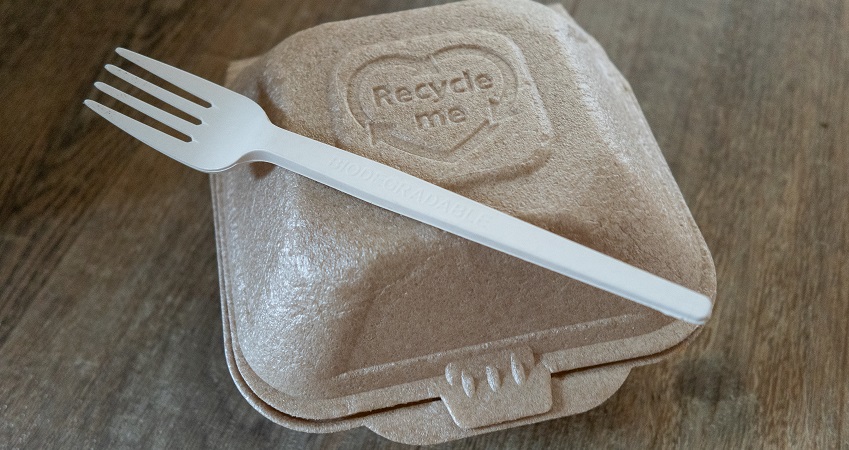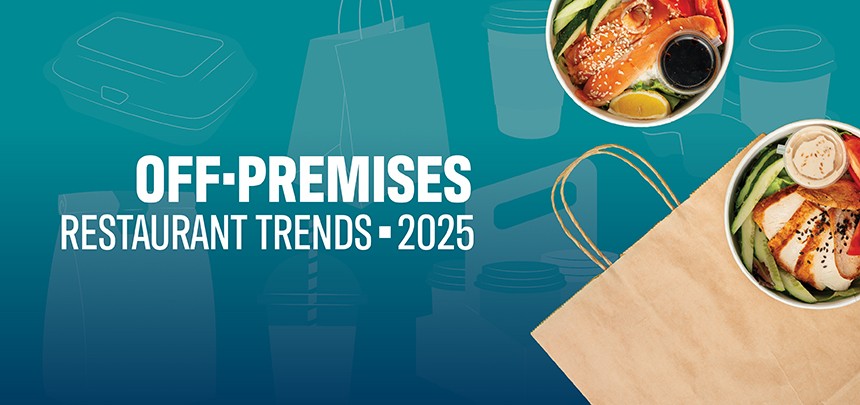Articles
May 21, 2025
Increased sales come in the right packages
Boosting your takeout, delivery or drive-thru sales can be as easy as investing in better food packaging, survey says.

Consumers are increasingly demanding compostable, recyclable, or reusable materials in their off-premises packaging.
According to the Association’s just-released 2025 Off-Premises Restaurant Trends report, the old adage “dress for success” applies when it comes to your food-to-go.
90% of off-premises customers say they’d likely order a greater variety of food items for takeout or delivery if the restaurant used upgraded packaging that helps hold food close to the temperature, taste and quality as when it’s served in the restaurant.
Not only are customers hungry for more off-premises food than they currently order, more than half, including 60% of Gen Z and millennial adults, are willing to pay extra for takeout and delivery if the packaging helps maintain food quality. After all, the reason they’re ordering takeout from your restaurant is your food; they simply want the food to more closely resemble what they experience when they dine in.
How do you know if the to-go packaging you use cuts the mustard? Order takeout or delivery from your menu and evaluate the meal that arrives on your doorstep. Give your staff coupons to order menu items at cost on their nights off in exchange for feedback or include a questionnaire for your customers with every to-go order. Have them evaluate your packaging on the basis of the following:
Pizza, for example, still transports best in cardboard boxes, and soup in a round polypropylene container with snap-on lid (which is both reusable and recyclable), or a round paperboard container with a leak-proof liner (preferably compostable). You have a wide range of choices, including glass, metal, foil, paper, paperboard, cardboard, plastics, compostables, and more.
The best way to choose the packaging material is to consider the type of food it will contain, the material’s environmental impact, and the local regulations it must meet both in terms of food safety and consumer safety. For example, opt for PFAS-free and BPA-free materials if choosing plastic containers, to prevent food contamination.
Run the same delivery or takeout tests with your staff, yourself, or your customers to see how different packaging stacks up with your menu items in the same areas:
Temperature. Consider both temperature retention and exposure. The former is how well the packaging holds the food’s temperature in transit, whether hot or cold. The latter is how well the material stands up to heat or cold. Can the package be microwaved or not? Aluminum, for example, retains heat well, but can’t be reheated in a microwave oven. Some plastic containers will melt if the food they contain goes above 140°F.
Integrity. Is the packaging robust enough to withstand bumps and bruises in transit? How well does the package hold the contents? Is it leak-proof? Is it tamper-evident or tamper-proof? Kraft paper boxes and bowls, for example, make good takeout packaging, but need some sort of moisture barrier or lining to prevent wet foods like soup or sauced items from leaking. That may make them less easy to recycle or dispose of.
Sustainability. Speaking of disposability, consumers increasingly demand compostable, recyclable or reusable materials in off-premises packaging (See the blog post on “How to transition to more sustainable food packaging.”) Fortunately, the number of options is growing rapidly, from compostable packaging and utensils made from PLA plastic, bagasse and other plant fibers, to straws made from wheat or paper. However, customers also want convenient ways to dispose of takeout packaging properly, which means letting them know how.
Aesthetics and presentation. Is the packaging attractive? Is it available in bold, vibrant colors, or with clear, transparent lids? Does it reflect the restaurant’s values and branding? Does it show off the food? Does it allow you to present the food the way you would plate it on a table? Is it Instagram-worthy? Does the food look appetizing? Has it shifted in the packaging during transit or does it still look “plated?” Are components—entrée, sides, dressings/sauces—still separate?
Versatility. Can you serve multiple items in the same package? Some packaging is suitable for both hot and cold food, for example. Some lines let you use the same lid on different size containers, reducing the number of items you need to keep on hand and simplifying the production process. Can packaging be reused by the customer, or serve another purpose?
Personality. Does the packaging fit your brand? Can you print your logo or branding on it? Can you personalize it with things like QR codes that provide additional information such as menu descriptions, nutrition, ingredient sourcing, reheating instructions, package disposal, etc.? Is there a way to add customer names, thank-you notes, or personalized messages? If not, can you include a branded piece—coupon, card, or logo sticker—inside the generic to-go bag? Even adding something as simple as a hashtag on branded packaging can encourage customers to share their experiences with your brand.
In the meantime, get your customers to place more off-premises orders—opt for takeout packaging that maintains food integrity when the rubber meets the road.
90% of off-premises customers say they’d likely order a greater variety of food items for takeout or delivery if the restaurant used upgraded packaging that helps hold food close to the temperature, taste and quality as when it’s served in the restaurant.
Not only are customers hungry for more off-premises food than they currently order, more than half, including 60% of Gen Z and millennial adults, are willing to pay extra for takeout and delivery if the packaging helps maintain food quality. After all, the reason they’re ordering takeout from your restaurant is your food; they simply want the food to more closely resemble what they experience when they dine in.
How do you know if the to-go packaging you use cuts the mustard? Order takeout or delivery from your menu and evaluate the meal that arrives on your doorstep. Give your staff coupons to order menu items at cost on their nights off in exchange for feedback or include a questionnaire for your customers with every to-go order. Have them evaluate your packaging on the basis of the following:
- Temperature
- Food texture integrity
- Visual appeal
- Package integrity
- Package attractivenessBranding impact
What to look for
Takeout packaging comes in all types of materials, sizes, shapes, colors, and price ranges. Get samples of different packaging to test, and experiment with off-premises orders of your different menu items. While it would be ideal to reach for one type of packaging in different sizes for all your menu items, some materials and packaging styles are better suited to certain foods.Pizza, for example, still transports best in cardboard boxes, and soup in a round polypropylene container with snap-on lid (which is both reusable and recyclable), or a round paperboard container with a leak-proof liner (preferably compostable). You have a wide range of choices, including glass, metal, foil, paper, paperboard, cardboard, plastics, compostables, and more.
The best way to choose the packaging material is to consider the type of food it will contain, the material’s environmental impact, and the local regulations it must meet both in terms of food safety and consumer safety. For example, opt for PFAS-free and BPA-free materials if choosing plastic containers, to prevent food contamination.
Run the same delivery or takeout tests with your staff, yourself, or your customers to see how different packaging stacks up with your menu items in the same areas:
Temperature. Consider both temperature retention and exposure. The former is how well the packaging holds the food’s temperature in transit, whether hot or cold. The latter is how well the material stands up to heat or cold. Can the package be microwaved or not? Aluminum, for example, retains heat well, but can’t be reheated in a microwave oven. Some plastic containers will melt if the food they contain goes above 140°F.
Integrity. Is the packaging robust enough to withstand bumps and bruises in transit? How well does the package hold the contents? Is it leak-proof? Is it tamper-evident or tamper-proof? Kraft paper boxes and bowls, for example, make good takeout packaging, but need some sort of moisture barrier or lining to prevent wet foods like soup or sauced items from leaking. That may make them less easy to recycle or dispose of.
Sustainability. Speaking of disposability, consumers increasingly demand compostable, recyclable or reusable materials in off-premises packaging (See the blog post on “How to transition to more sustainable food packaging.”) Fortunately, the number of options is growing rapidly, from compostable packaging and utensils made from PLA plastic, bagasse and other plant fibers, to straws made from wheat or paper. However, customers also want convenient ways to dispose of takeout packaging properly, which means letting them know how.
Aesthetics and presentation. Is the packaging attractive? Is it available in bold, vibrant colors, or with clear, transparent lids? Does it reflect the restaurant’s values and branding? Does it show off the food? Does it allow you to present the food the way you would plate it on a table? Is it Instagram-worthy? Does the food look appetizing? Has it shifted in the packaging during transit or does it still look “plated?” Are components—entrée, sides, dressings/sauces—still separate?
Versatility. Can you serve multiple items in the same package? Some packaging is suitable for both hot and cold food, for example. Some lines let you use the same lid on different size containers, reducing the number of items you need to keep on hand and simplifying the production process. Can packaging be reused by the customer, or serve another purpose?
Personality. Does the packaging fit your brand? Can you print your logo or branding on it? Can you personalize it with things like QR codes that provide additional information such as menu descriptions, nutrition, ingredient sourcing, reheating instructions, package disposal, etc.? Is there a way to add customer names, thank-you notes, or personalized messages? If not, can you include a branded piece—coupon, card, or logo sticker—inside the generic to-go bag? Even adding something as simple as a hashtag on branded packaging can encourage customers to share their experiences with your brand.
Packaging innovation
Suppliers continue to make huge strides in performance and sustainability in takeout packaging. Some recent innovations include:- A transparent plastic clamshell container that is ridged and vented to ensure that fried foods remain crisp and hot. Reusable and recyclable, the anti-fog container costs less than a coated paperboard box.
- A coffee cup that can be recycled in standard paper recycling mills. The cups, made from recycled paper, feature a thin plastic liner that is dropped in and lightly glued in place, making it easy to separate from the cup during recycling.
- Stylish containers made from wheat straw that feature special ridges and vent holes to keep food fresh and warm. Durable, grease-resistant and compostable, the containers can go from freezer to microwave.
- A frozen gelato to-go kit that includes a container for hand-scooped gelato, cones, and carrying case.
- Recyclable and compostable containers with PLA liners or aqueous liners that are grease- and moisture-resistant.
- Tamper-resistant, tamper-evident, transparent, anti-fog polypropylene packaging that is microwaveable and dishwasher-friendly.
In the meantime, get your customers to place more off-premises orders—opt for takeout packaging that maintains food integrity when the rubber meets the road.
Get the report
Get the report
Sign up for our Newsletter
The latest news from the National Restaurant Association, published every other Thursday
By clicking Submit I agree to receive email communications from the National Restaurant Association and agree to our Privacy Policy(Opens in a new window).
